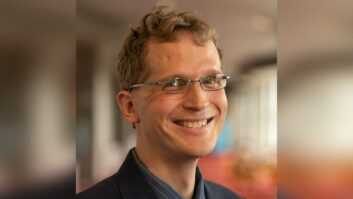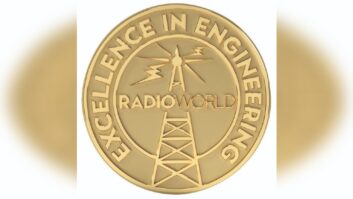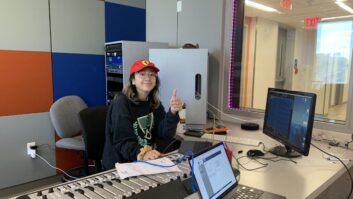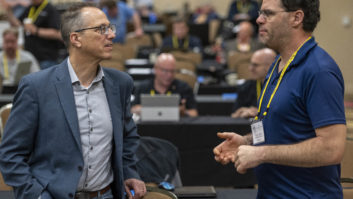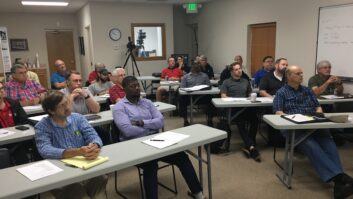FALLBROOK, Calif. You see it in the neat rows of cherimoya fruit trees in the orchard of his summit home in Fallbrook, north of San Diego. You see it in his tidy laboratory. His clients can attest to his relentless discipline. Bob Gonsett knows exactly how he likes things done.
Bob Gonsett, consulting radio engineer, started life in Los Angeles, and there is no way you can understand him without knowing a thing or two about his father.

Bob Gonsett in his lab. Credit: Photo by Gary Stigall Faust Gonsett invented the two-way radio for police motorcycles and was chief engineer of the Beverly Hills, Calif., Police Department at an early age. He then founded the Gonsett Company, which manufactured a variety of amateur radio products including the VHF Communicators affectionately known as “Gooney Birds.” The firm also manufactured TV antennas that were sold nationwide by Sears Roebuck as well as some of the earliest FM broadcast converters for cars.
Fascinated with the electronics at his father’s plant, Robert Gonsett took up amateur radio, passed his Novice exam at age 13 and soon advanced to General as WA6QQQ.
“Even the kings of old couldn’t cast their voices around the world, but we could as amateur operators, and there were so many interesting people to meet,” he recalls. When ham vanity call signs became available, he got his father’s old call, W6VR.
After moving to San Diego County as a teenager, the young Gonsett found his way onto Mt. Soledad and became fascinated with the high-powered transmitters at KOGO(TV), which is now KGTV. He also became hooked on FM when the transmitter serving KJLH (now KIFM) needed serious repair.
His father died about the time the teenager graduated from high school. Bob met his future wife and office partner Judy at the University of Southern California; she later joined him near Boston when Bob was studying by day for his electrical engineering degree at the Massachusetts Institute of Technology while teaching scuba diving for the school at night and on weekends. He was MIT’s first underwater instructor.
Gonsett enjoyed listening to classical music on WBCN(FM) Boston, though the station (which is now WBMX) had some serious technical problems.
“One day I went over and asked if I could fix their transmitter since I liked the music but they had this little problem,” Gonsett said, who was 20 years old at the time. “They had been off the air for days, and said, ‘Have at it!’ Next thing I knew, they made me chief engineer — all while carrying a full course load at MIT and teaching scuba in the evenings.”
FCC experience
“WBCN was a lot of fun because there were so many problems to fix, from a poorly designed new transmitter to a near-prototype Shively antenna where portions of the bays exploded each winter due to an unstable RTV compound. The work was sort of like amateur radio carried to an extreme, but the work was easy because I had been doing that kind of stuff all my life.”
Gonsett got his first taste of consulting when he engineered the WBCN transmitter move to the Prudential Tower, with all its attendant challenges.
Gonsett, now 63, fondly remembers his first serious encounter with the Federal Communications Commission. He had to work out a short-spacing deal with the local engineer-in-charge in order to make the WBCN move. The EIC agreed to the plan — and that’s all there was to it. The process was “much simpler than getting a waiver today.”
He graduated with a Bachelor of Science degree in electrical engineering from MIT in 1970 and took off to the Caribbean, where he quickly became chief engineer of the Caribbean division of Cable and Wireless/Western Union International. He used his pilot’s license to visit outlying offices — and of course taught scuba on weekends. “The work was fun but not a career.”
Soon Bob and Judy returned to southern California and he became chief engineer for KOWN(AM/FM), Escondido, and KFSD(FM), San Diego. He almost immediately branched out into consulting with his own firm, Communications General Corp.
CGC is known for frequency and spectral measurements as well as its California-centric e-mailed newsletter, but the vast majority of its business is in consultant radio engineering that often progresses out of sight.
He’s shown great stamina in his career. Gonsett fought for years with incumbent land-mobile users and the custodian USDA Forest Service to install a heavily filtered 530 watt ERP FM transmitter for KWVE on prominent Santiago Peak in Orange County, Calif. The Forest Service insisted the station would cripple incumbent land-mobile communications. It took a court proceeding and exhaustive field measurements to prove no harm, and “K-WAVE” prevailed.
For a small Class A FM station in Carlsbad, he orchestrated a monumental move, shuffling adjacent and co-channel stations on both sides of the U.S.-Mexico border until KKOS could move to 95.7 MHz and obtain a Class B license at the desirable Mt. Soledad site in San Diego, in essence moving the station to the big city. He convinced the FCC to use his Longley-Rice calculations to prove sufficient coverage of the city of license — a showing Gonsett feels would have been rejected with the traditional F(50,50) propagation methodology.

Gonsett appeared on the cover of Radio & Television News in May, 1954, published by Ziff Davis, along with a man who worked at his father’s radio manufacturing plant and the man’s wife. HD too soon?
Perhaps his biggest accomplishment to date involved designing and overseeing the construction of a major new radio and television transmission site in the Tucson Mountains in Tucson, Ariz. That location gave broadcasters a site close to the metropolitan population with far better winter access and maximum-facility RF plants.
Close attention was paid to site construction so that high-power broadcasting could live harmoniously with sensitive land-mobile and cable TV receivers. According to Gonsett, the project took years to complete and involved numerous environmental issues, one of the first uses of Longley-Rice calculations in an FCC hearing and some envious TV broadcasters who opposed the project.
“That project was much more contentious than, say, the development of Mt. Harvard in Los Angeles.” Regarding trends at the commission, Gonsett said, “On AM we have a lot of drop-ins and a lot of man-made noise, now exacerbated by HD sideband interference.
“A classic example of AM HD Radio interference would be KNX at 1070 kHz and KDIS at 1110 kHz, each in Los Angeles, causing interference to 50 kW XEPRS at 1090 kHz that transmits from a point near Tijuana, Mexico. Specifically, XEPRS’ analog signal had been regularly received in the Los Angeles basin and Orange County until HD transmissions were initiated in L.A.”
Gonsett feels that HD Radio was introduced “way before its time — the bugs weren’t worked out.” His FM clients, he said, may self-inflict damage to their analog signals with the granted 6 to 10 dB IBOC power increase, and he already sees interference from “HD intermodulation regrowth,” which he describes as a “widespread, nationwide problem.”
“Over the years, radio has devolved from a high-quality service with fringe area coverage to a ‘sorta sounds okay’ media where fringe service is being destroyed by noise.”
Communicator
From the launching of his business, Gonsett has kept in touch with clients through a newsletter informing them about FCC statements and spectrum changes that could affect them, as well as other items of interest.
The CGC Communicator began more than 35 years ago as a hand-written sheet; later it was typed. In 1996 it evolved into an e-mail bulletin and now has more than 1,000 subscribers, according to Gonsett.
Last fall, when the Station Fire in Los Angeles threatened broadcast transmitters on Mt. Wilson and Mt. Harvard, Gonsett felt special urgency in his mission to inform regional engineers, and he became an ad hoc message center for those sites. Gonsett said broadcast engineering managers became deeply concerned when Mt. Wilson and their facilities appeared to be threatened by a burn-over and firefighters were being pulled off the mountain.
Gonsett donated his time to keep communications flowing between the Forest Service, site users and patrol officers. His sometimes multiple daily posts gave important insights for stakeholders. Newsletter subscribers in other parts of the country followed the Mt. Wilson broadcast-related communications with fascination. Ultimately, the burn-over didn’t happen.
San Diego’s SBE Chapter 36 in December honored Bob Gonsett with a Lifetime Achievement plaque as part of a holiday banquet. In giving the award, the chapter cited his work in the service of Southern California broadcasters over the past four decades, and in particular, during the fires this past fall.
Will he retire?
“I bill myself as being semi-retired, but I love the work — and the people in this business are terrific.”
Gary Stigall, CPBE, is director of engineering for Televisa’s Bay City Television in San Diego, a past client of Communications General Corp. Stigall has been a radio and TV broadcast engineer since 1977.







